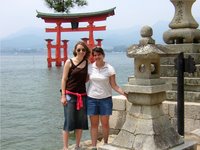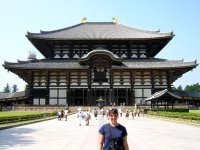Japan!
My exploits in the country to the East
So I left Pyeongtaek for Japan with Jaclyn on July 29th (a Saturday). It’s only an hour and fifteen minute flight to Japan from Seoul. We found it humorous that it took longer to get from Pyeongtaek to the airport in Seoul than it took for us to get from the airport (in Seoul) to the train station in Osaka. Our onboard dinner was eel and fish. And rice. The eel wasn’t too bad but I dislike fish. A lot.
Japan almost didn’t let me into the country. I say it was due to my ugly haircut, but I don’t think I’ll ever know for sure. We filled out our embarkation cards or whatever, and had to give them to the customs people. We both forgot to fill out the back (which was like 2 boxes where you had to check “No, I didn’t bring any drugs into the country.” Jaclyn’s customs guy let her quickly fill it out when she was up there. My lady made me leave and go fill it out at some table. Great. So I filled it out and waited to get back to the customs person. Then there’s a question on the card that asks for your intended address in Japan. I just put Osaka because we didn’t know what hotel we were staying at. Jaclyn wrote the same thing. They let her through no problem. They then proceeded to hassle me about where I was staying. Which was confusing because they didn’t speak English well and I speak no Japanese. They were like, “Are you visiting a friend?” “No.” “What hotel? Write the address here.” “I don’t know what hotel. No reservations.” Etc. This went on for a while. Finally they let me though. Crikey. I though it was weird because I would assume a lot of people may not know what hotel they’re staying at when they first arrive. Anyway, I managed to get into the country, so that was good.
We ignored the people at tourist info booths various times while on our trip. The first being when we first arrived. We got to Japan and went to the tourist info place at the airport to see if they could tell us where to get a cheap hotel to stay at that night (it was getting pretty late and by the time we got into the actual city of Osaka it’s be around 11pm or so). The lady gave us
one hotel option and it was the equivalent of $140/night. We asked if we could find a cheaper place on our own and she said she didn’t know. We were a little nervous, but ultimately decided that there had to be cheaper places than that to be found. I mean, I know Japan is expensive, but
$140? Come on.
So after taking the train into
Osaka we just left the station searching for a cheap hotel (we were only staying in Osaka that night before heading to Hiroshima the next morning). Now, in Korea there are a bunch of “Love Hotel.” Named love hotels because it’s where people go to…love…one another. Often with a prostitute or mistress. Anyway, many love hotels in Korea are actually pretty nice/clean, but they’re cheaper than other hotels. I’ve stayed in a few and they’ve all been fine. One even had a dvd player and computer with internet. So anyway, we thought maybe we’d find a love hotel to stay at. We walked into the first place we saw...the sign outside was all in Japanese, but we did understand the 2,900 yen part ($29). Definitely seemed very reasonably. The desk people looked at us a little weird then told us that they had no room. Ok. Onward to the next
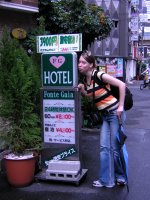
place. Same thing occurs. I think maybe they’re turning us down because we’re 2 girls and they don’t cater to homosexuality or something. Anyway, we then see another sign that has some English on it. It turns out that we were walking into places that only rent out rooms by the hour!! Hahahahahaha!!! I’m guessing they all just knew we didn’t understand what was going on and saying they had no rooms left was the easiest thing to say to us. But we then found a place that was definitely more reputable looking and got a very small twin room for about $25/person. I’ve included a picture of the sign we saw that clued us in to the by-the-hour thing that we took the next morning.
Let me just take a moment to say that it was friggin’ hot in Japan. And humid as hell. Ugh, I shudder just thinking about it. Lonely Planet said something about traveling in Japan at this time that was akin to, “Walking outside turns into an immediate soup bath.” That’s about it. It was constant nasty sweating. Horrid. I hate sweat. Ugh. So yeah, it was super hot. Also, before we left I checked the weather for Japan for that week and it said it’d be rainy the whole time. Great. Now, I have this poncho that I bought a couple of years ago before going on a hiking trip. It’s in this miniscule package and I always think that once I take it out there’s no way I will be able to fit it back in that package. Luckily, I’ve never had to take it out. I call it my lucky poncho because every time I bring it on a long trip with me I never need to use it. So I packed my lucky poncho. Did it ever rain while I was in Japan, I ask?? No, sir! Lucky poncho pulls through! Still sittin’ pretty in its miniscule package. So that was nice…although I wouldn’t have minded more clouds instead of constant blazing sun.
This entry will get really long. I should break it up into parts, but then people will probably read it in the wrong order. So I won’t. So deal with it.
The next day we went from Osaka to Hiroshima via train. We bought train pass things which turned out to be very handy (if you go to Japan and plan on using the trains a lot buy a JR Pass because it’ll save you money…but you have to buy it outside Japan, so plan accordingly). Trains are really expensive in Japan. It’s about a 2 hour train ride from Osaka to Hiroshima. We asked the Osaka info people about what train to take. They gave us a really confusing answer involving multiple transfers and a whole hell of a lot of time. While waiting for our train, we noticed another train coming that seemed to us to be a much better option. So we ignored the info people again and got on a different train (a lot of trains have no reserved/assigned seating). This new train involved transferring at one city, which happened to be a city we wanted to stop in (Himeij) because it is the home of a castle. So we took the train to
Himeji, and went to Himeji-jo…Or Himeji Castle.
Himeji Castle is one of the oldest surviving structures from medieval Japan, and has been designated a UNESCO World Heritage Site. Sometime it’s called the White Heron Castle…because it’s white. One of the castle’s most important defensive elements is the conf
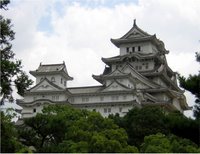
using maze of paths leading to the main keep. The gates, baileys, and outer walls of the complex are organized in a way that requires an approaching force to travel in a spiral pattern around the castle on their way into the keep, facing many dead ends. This allowed the intruders to be watched and fired upon from the keep during their entire approach. But Himeji was never attacked in this manner, so the system remains untested. Also, the wooden floors in the castle are built to be really squeaky as another defensive measure…no one can sneak around/in the castle. It was pretty cool. See picture. We then boarded another train to get to Hiroshima. We ended up getting to Hiroshima in the same amount of time it would have taken us if we had followed the info people’s advice…but using our way we also saw the castle.
So we arrived in
Hiroshima on Saturday afternoon. We asked the info people about hotels and they gave us a few nice sounding options, one of which we took. We stayed 2 nights/3 days in

Hiroshima. That day we walked around the
Peace Park. It is a really nice park, built right around the hypocenter of the A-Bomb explosion. It has all kinds of monuments in it. I have a lot of pictures of the Peace Park. This first picture is of the monument that houses the
cenotaph that lists all the Japanese who died in the bombing. Each year they add more names to the list, as people are still dying from ailments/diseases caused by the radiation from the bomb. You can see in the background the A-Bomb Dome (which I’ll discuss soon) and the Peace Flame (although you can’t really see the flame in this picture). The
Peace Flame will remain lit until all nuclear bombs on the planet are destroyed and the planet is free from the threat of nuclear annihilation. As a tidbit of info, any time a nuclear test of any kind occurs, the city of Hiroshima sends that country a letter of protest. You can see lots of these letters in the
museum located in the park.

The
A-Bomb Dome is the skeletal ruins of the former Industrial Promotion Hall. It is the building closest to the hypocenter of the nuclear bomb that remained at least partially standing. It was left how it was after the bomb in memory of the bombing. It is probably the most well-known symbol of the park. This is a UNESCO World Heritage Site. I took a picture of it in daylight and at night when it’s lit up. I also included a picture I found of the building prior to the A-Bomb explosion.
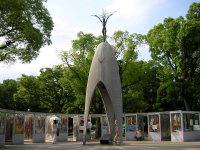
This is a
monument to the A-Bomb Children. The statue is dedicated to the memory of the children who died as a result of the bombing. The statue is of a girl with outstretched arms with a crane rising above her. The statue is based on the true story of Sadako Sasaki, a young girl who died from radiation from the bomb. She believed that if she folded 1,000 paper cranes she would be cured. To this day, people (mostly children) from around the world fold cranes and send them to Hiroshima where they are placed near the statue. The statue has a continuously replenished collection of folded cranes nearby. The millions of cranes are assembled into long strings or into collages making up pictures, often presenting an inspiring message of peace and world fellowship. After display, the cranes are pulped and recycled into bookmarks, notebooks and other souvenirs. They’re kept in those cases to protect them from rain, etc.
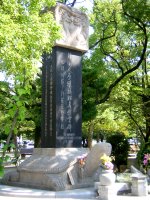
Here is the
memorial for Korean victims of the bomb and includes a cenotaph with all the Korean victims from the bomb. Japan was occupying Korea during World War II and had lots of Korean forcibly working in Japan at the time, including many in Hiroshima. It’s thought that 1 in 10 (I’ve also seen 1 in 7) of the victims were Korean. Almost 20,000 Koreans died from the bomb. The Cenotaph was originally dedicated in 1970, but prejudice that remained between the Japanese and Koreans kept the Cenotaph outside the Memorial Park until 1999, when the then mayor of Hiroshima allowed it back into the park.
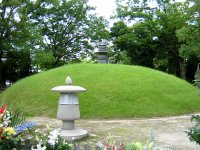
The
Atomic Bomb Memorial Mound is a large, grass-covered knoll that contains the ashes of 70,000 unidentified victims of the bomb.
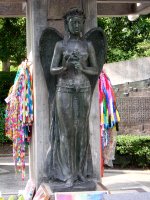
Here is a statue from a
monument dedicated to the students who died in the bomb. In Japan during World War II, everyone was enlisted to help with war efforts, including school children. Japan knew that Hiroshima was a target because it housed an important military base, so prior to the bombing they had evacuated quite a few young children out of the city (but not all). Actually, throughout the war (until the atomic bomb) Hiroshima was never bombed/air-raided because the US knew it was a possible target for the atomic bomb and they wanted to be able to accurately measure the destruction of the atomic bomb.
Anyway, there were some other monuments as well, but these are the ones for which I took pictures. A few days later we went to the Peace Museum located in the park. It’s a very nice museum, albeit depressing. It’s all about the bombing of the city and has all kinds of artifacts displayed and information and stuff.
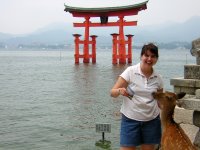
The next day we took a trolley and train and ferry ride for a day trip to
Miyajima, an island near Hiroshima, which is considered one of the 3 most scenic spots in Japan. In the Shinto religion the island is considered to be sacred and there are no maternity wards or cemeteries, as no one is permitted to give birth or die on the island (I actually don’t know if this is still true, but it used to be, anyway). Cutting down trees is also forbidden, leaving the island covered in virgin forest and providing a habitat for dozens of bird species and deer which are allowed to roam freely (and are considered national treasures). One deer attempted to eat both my map and my passport…which you can see in a pic I’m including.
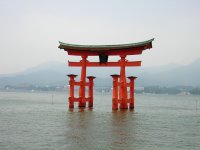
Located on Miyajima is the
Itsukushima Shrine and its floating torii (gate). I included lots of pictures of this since it’s apparently one of the best views in Japan (it was kind of foggy-ish when we were there). This is also a UNESCO World Heritage Site.
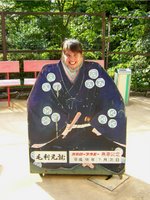
Also on Miyajima is
Daisho-in temple, a Buddhist temple (Itsukushima Shrine is of the Shinto religion). We also took a cable car up
Mount Misen where there was a nice view of the islands in the Inland Sea. Apparently
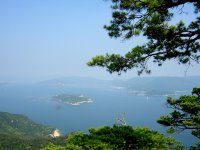
sometimes there’s monkeys up there, so Jaclyn and I were both a little nervous (we both have had mildly frightening experiences with monkeys…me in Thailand and her in Bali). However, we didn’t see any monkeys.
The next day we went to the Peace Park again. There was a big group of little Japanese school kids there who were practicing their English (5 year olds). We were approached by quite a few of them: “Do you have a moment? What is your name? Where are you from? Do you like Japanese food?” Etc. It was adorable. Then they gave us paper cranes they folded (or their moms folded, as one kid said). So it was nice to get paper cranes from little Japanese kids in the Peace Park the week of the anniversary of the bombing. [It’s weird to use the word anniversary when talking about a very unhappy event]
We then took a train to
Kyoto. We got there late at night. We tried walking around and finding a hotel on our own, but we weren’t having any luck so we went back to the station and asked the info people for help. He ended up calling a lot of places for us (lots of places were full). We ended up staying in a hostel that was pretty cheap, but was also pretty much a piece of crap. We stayed there 3 nights. One person at the hostel who came our second night said that Kyoto was all booked up. So at least we weren’t sleeping on the street (and only had to spend $20/person/night).
By the time we got to Kyoto I had huge blisters on the bottoms of both my feet (right on the balls of my feet). It was very painful to walk. Excruciating as the day went on and I had been walking for a while. I started walking on different parts of my feet to avoid stepping on the blisters, but this just made the rest of my feet extremely sore (as well as my shins). I don’t think my feet ever hurt so much as they did on this trip. Seriously. Which really sucked, but hey. To describe the weather--“Due to the surrounding mountains on all sides, Kyoto is famous for its stifling summer nights with no air movement.” The nights weren’t too bad, but the days sure as hell were stifling.
Anyway, we hit up the main spots in Kyoto, all of which were UNESCO World Heritage Sites.

Kinkaku-ji Temple
Very pretty, but the original was burnt down by an obsessed monk in 1950, so this one is a rebuilt version. It’s also referred to as the Golden Pavilion.
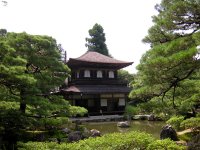 Ginkaku-ji Temple
Ginkaku-ji TempleThe actual temple here wasn’t too amazing, but the walk around it was really pretty—lots of woods and moss and stuff. It’s also referred to as the Silver Pavilion, but it was never covered in silver. So the name doesn’t really fit.
 Kiyomizudera
KiyomizuderaKiyomizudera ("Pure Water Temple") is one of the most celebrated temples of Japan. It was founded in 780 and remains associated with the Hosso sect, one of the oldest sects within Japanese Buddhism. Okay, but not that amazing.
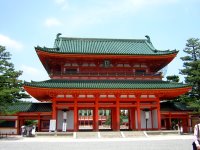 Heian Shrine
Heian ShrineHas a pretty nice garden stroll, albeit a bit pricey ($6). I thought I was going to die of heat while I was here.
Fushimi-Inari-taisha ShrineDedicated to Inari, the Shinto god of cereals, Fushimi-Inari-taisha is the head shrine (taisha) for 40,000 Inari shrines across Japan. Stretching 230 meters up the hill behind it are hundreds of bright red torii (gates). This was probably my favorite thing in Kyoto. It wasn’t so crowded and I liked how it was very woodsy (which also helped keep it a bit cooler than other places).
After Kyoto we took a day trip to
Nara. Nara is an ancient capital of Japan. It also has a crap-load of the UNESCO sites. It also was super hot here. Like Miyajima, there are deer than roam around the city (regarded as messengers of the gods by Shinto).
Todai-jiA Buddhist temple and reputedly the largest wooden building in the world. Inside there’s a giant statue of the Buddha Vairocana.
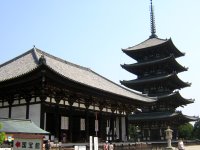 Kofuku-ji
Kofuku-jiAnother Buddhist Temple
Kasuga ShrineA Shinto Shrine thats interior is famous for its many bronze lanterns. Also, many stone lanterns lead up the shrine. Over a thousand stone lanterns line the path to the Shrine. This was my favorite thing in Nara.
That day we took a train back to
Osaka. That night for dinner we had sushi and sake…and pizza…in an interesting restaurant experience as the menu had only Japanese and no pictures. But the waitress spoke a little English and was super nice. We woke up the next day and headed right to the airport, where we then flew back to SoKo.
I had a really good time in Japan, even though it was hotter than bejeezus and my feet hurt like a beotch. I really like Japan. All the people were super nice and helpful. Also, I didn’t get stared at because I was white like I do in Korea. Which was nice. With the combination of Korea and Japan I’d say I’m sufficiently templed-out…one can only see so many temples. But Japan was really pretty (they don’t have rows upon rows of high-rise apt buildings like Korea!). Also, old Japanese women are cute and sweet…old Korean women are scary and rude. The Japanese seem very polite. Maybe if I lived in Japan I’d notice more things or get annoyed by more things, but the short time I was there I really liked it. It was a nice change from Korea. When I got back to Korea I found that monsoon season was over and it's now into super hot season. Great.
And that’s all I can write for now because I’m officially on page 6 of this word document (and that’s without the pictures!). I need a break. As do you, I’m sure.













